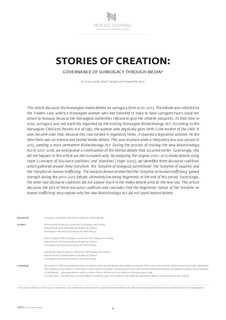| dc.contributor.author | Levold, Nora | |
| dc.contributor.author | Svingen, Marit | |
| dc.contributor.author | Aune, Margrethe | |
| dc.date.accessioned | 2019-05-29T06:34:06Z | |
| dc.date.available | 2019-05-29T06:34:06Z | |
| dc.date.created | 2019-05-22T18:35:43Z | |
| dc.date.issued | 2019 | |
| dc.identifier.citation | Nordic Journal of Science and Technology Studies. 2019, 7 (1), 4-17. | nb_NO |
| dc.identifier.issn | 1894-4647 | |
| dc.identifier.uri | http://hdl.handle.net/11250/2599338 | |
| dc.description.abstract | This article discusses the Norwegian media debate on surrogacy from 2010–2013. The debate was initiated by the ‘Volden-case’ where a Norwegian woman who had travelled to India to have surrogate twins could not return to Norway because the Norwegian authorities refused to give the children passports. At that time in 2010, surrogacy was not explicitly regulated by the existing Norwegian Biotechnology Act. According to the Norwegian Child and Parents Act of 1982, the woman who physically gives birth is the mother of the child. It soon became clear that, because this case existed in regulatory limbo, it required a legislative solution. At the time there was an intense and heated media debate. This was resolved when a temporary law was passed in 2013, pending a more permanent Biotechnology Act. During the process of revising the new Biotechnology Act in 2017–2018, we anticipated a continuation of the intense debate that occurred earlier. Surprisingly, this did not happen. In this article we aim to explain why. By analyzing the original 2010–2013 media debate using Hajer’s concepts of ‘discourse coalitions’ and ‘storylines’ (Hajer 2003), we identified three discourse coalitions which gathered around three storylines: the ‘storyline of biological parenthood’, the ‘storyline of equality’ and the ‘storyline on human trafficking’. The analysis demonstrated that the ‘storyline on human trafficking’ gained strength during the 2010–2013 debate, ultimately becoming hegemonic at the end of this period. Surprisingly, the other two discourse coalitions did not appear much in the media debate prior to the new law. This article discusses the lack of these discourse coalitions and concludes that the hegemonic nature of the storyline on human trafficking’ may explain why the new Biotechnology Act did not spark heated debate. | nb_NO |
| dc.language.iso | eng | nb_NO |
| dc.publisher | NTNU Norwegian University of Science and Technology. | nb_NO |
| dc.rights | Navngivelse-DelPåSammeVilkår 4.0 Internasjonal | * |
| dc.rights.uri | http://creativecommons.org/licenses/by-sa/4.0/deed.no | * |
| dc.title | Stories of Creation: Governance of Surrogacy through Media? | nb_NO |
| dc.type | Journal article | nb_NO |
| dc.type | Peer reviewed | nb_NO |
| dc.description.version | publishedVersion | nb_NO |
| dc.source.pagenumber | 4-17 | nb_NO |
| dc.source.volume | 7 | nb_NO |
| dc.source.journal | Nordic Journal of Science and Technology Studies | nb_NO |
| dc.source.issue | 1 | nb_NO |
| dc.identifier.doi | 10.5324/njsts.v7i1.3066 | |
| dc.identifier.cristin | 1699610 | |
| dc.description.localcode | Copyright © 2019 The Author(s). Open Access. Creative Commons Attribution-ShareAlike 4.0 license. | nb_NO |
| cristin.unitcode | 194,62,40,0 | |
| cristin.unitname | Institutt for tverrfaglige kulturstudier | |
| cristin.ispublished | true | |
| cristin.fulltext | original | |
| cristin.qualitycode | 1 | |

